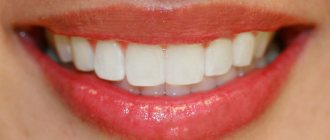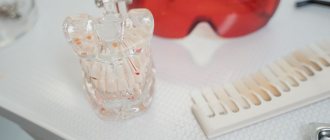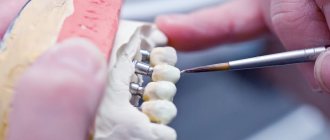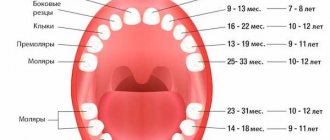Like any medical intervention, correcting the bite has its contraindications, which is why an examination is carried out when preparing to install braces or aligners. There are patients who either cannot or are not recommended to wear braces, but some contraindications can be eliminated - the doctor will give recommendations for this.
There are contraindications to correcting the bite, but they are few.
Absolute contraindications
These are those in which correcting the bite is either impractical or impossible.
- Most of the teeth are missing.
If the chewing teeth on both sides of the upper and lower jaws have been destroyed, removed or missing, then it often makes no sense to correct the position of the remaining ones. When preparing for prosthetics, the doctor will most likely offer an alternative option.
If you have only a few teeth, braces cannot be installed.
- Dystrophic processes in the jaw bone, periodontal disease.
Bone atrophy or thinning are synonymous. The essence of the process is that bone tissue cells are not renewed, the volume of the bone gradually decreases, the roots of the teeth begin to stay in it worse and can become loose. This process requires supervision by a dentist or periodontist, since with due attention to your health, you can slow down the development of the disease and save your teeth. But treatment by an orthodontist, which is accompanied by a strong impact on the roots of the teeth, is no longer carried out.
It is possible to correct a bite if the tissue of the jaw bone is dense and holds the roots of the teeth well.
- Several implants.
Even one implant puts the possibility of correcting the bite into question, since usually when wearing braces or aligners, all teeth move to one degree or another. And if there are several implants, it is impossible to avoid pressure on them. Unlike tooth roots, implants are not able to withstand such a load.
The generally accepted procedure is: first treatment with an orthodontist, and only then installation of implants.
Popular myths
1. It's not nice. There is a myth that fixed appliances do not look very aesthetically pleasing, and the person wearing them cannot look attractive. But modern braces do not affect the aesthetics of a smile. Firstly, there are lingual braces that are completely invisible to others. Secondly, even external braces can be beautiful: sapphire, ceramic, and plastic structures can even add a certain charm to your smile.
2. Braces are only for children. Many patients still have associations with braces - teenage schoolchildren. But it has no basis. Children and adolescents have more options and correction methods, and removable orthodontic appliances are more often used. Adults with a mature dental system have fewer options - braces are used more often as a powerful tool. It is worth noting that there are no upper age restrictions for braces - they are successfully used at both 25 and 60 years old. The older the patient, the longer the retention period, that is, the result will have to be consolidated longer, and this is the only age difference;
3. It hurts. This myth has a reasonable explanation; indeed, pain and discomfort do occur, but not all the time. It may be painful the first few days after installation. This is a normal symptom that occurs as a result of pressure on the teeth. Most patients report moderate pain and itching in the gums, which go away on their own and do not require correction with medications. But everyone has their own pain threshold and perception of pain, so the doctor will tell you how to get rid of unpleasant sensations.
4. It's harmful. It is believed that the non-removable structure destroys the teeth. But preliminary diagnosis is needed in order to assess the strength of the enamel and the risks of complications. Normal enamel can withstand the structure, and compliance with hygiene and doctor’s recommendations eliminates the risk of developing caries in areas of the teeth near braces.
Relative contraindications
These include contraindications that, in different individual cases, may interfere with treatment, or may not have a significant impact on the process.
- Several crowns.
If prosthetics have been performed in the past, then when preparing for treatment you need to pay close attention to the crowns. On what teeth are they installed? What is the condition of the roots of these teeth? Have the crowns and their connection points begun to collapse? Which teeth will be impacted the most and which will move 1-2mm? By answering these questions, your doctor will be able to tell you whether you can wear aligners or braces. Sometimes you need to first have the crown redone and then be treated by an orthodontist.
Crowns, unlike implants, can be moved (but carefully)
- A large number of fillings.
If you have 10 or more teeth filled, the fillings themselves are large (they take up more than 50% of the tooth’s volume), and nerves have been removed in some teeth, this does not mean that the bite cannot be corrected. You just need to more carefully examine all the fillings and find out if they have begun to collapse. The doctor may recommend replacing old fillings. Modern materials for treatment make it possible to save even “dead” teeth.
- Previous tooth restoration.
Veneers are not installed if there are malocclusions, since improper closure of the teeth can lead to destruction and abrasion of the plates. Therefore, there is no point in talking about this technology. However, if in the past one or more teeth were restored using filling material, then, as a rule, this does not prevent you from subsequently wearing aligners or braces - the only question is the quality of the restoration and its condition.
A restored tooth, if its root is not damaged, is not an obstacle to treatment
Is it possible to put braces on crowns, fillings and implants?
The issue of compatibility of braces with crowns, bridges and other prosthetic structures is decided in each case individually. Using classical systems in such cases can lead to certain problems. Thus, fixing a bracket on a crown is much more difficult than on natural dental tissue. Therefore, instead of fixed metal braces, the patient can be offered a Invisalign aligner .
| Treatment on aligners (aligners) For people who strive for beauty and aesthetics, but feel fear at the thought of braces, modern orthodontics offers an excellent solution - aligners for straightening teeth. This is an innovative way to combat malocclusion. Orthodontics offers its patients high-quality and comfortable bite correction and teeth straightening using the latest technologies - transparent cap-aligners. | 250 000 ₽ |
If there are bridges and implants in the oral cavity, then there is no longer any need to talk about special mobility of the teeth. Therefore, it is difficult to attempt to move the bridge (which can result in its damage) and to change the position of the implant. But an experienced professional has at his disposal techniques that allow even in such cases to correct the bite using a brace system without negative consequences - of course, if this is really necessary.
Temporary contraindications
These are the ones that are easy to fix. Having identified them during the examination, the orthodontist will give recommendations, and soon after treatment it will be possible to begin correcting the bite.
- Caries.
When wearing any orthodontic structures, plaque forms much faster, and it is more difficult to clean it. Although braces and aligners themselves do not cause caries, attention to hygiene during orthodontic treatment should be much higher. Therefore, removal of all foci of caries, including superficial ones, is an indispensable condition before starting treatment.
- Plaque, tartar.
The reasons are the same as described above. The bite is corrected with perfectly clean teeth. To prepare, it is enough to undergo ultrasonic cleaning (it perfectly removes hard plaque) and air flow (removes soft plaque).
Those who want to correct their bite should get used to more careful dental care. This is a great habit that will help you stay healthy for many years and avoid prosthetics in the future.
- Inflammation of the gums.
Minor inflammation may occur due to accumulated soft plaque. After professional dental hygiene, as a rule, it is enough to follow the doctor’s recommendations for several days (usually the use of local antiseptics) to eliminate the problem.
Which braces are most often installed in adults?
It is most rational to choose metal braces: they are the most durable, and since the treatment will be long, this is one of the most important indicators. When it comes to minor corrections, aesthetic systems made of ceramics or artificial sapphires can be installed. But, let’s say, ceramic braces are quite fragile compared to metal ones. If the ceramic lock is chipped, you will need to remove it and install a new one. And this is a waste of time: when the lock is re-glued, the treatment can be considered to begin anew. When choosing a brace system, it is best to listen to the orthodontist’s recommendations - the doctor selects or combines types of structures so that the treatment is as comfortable as possible.
Not a contraindication
- Childhood.
The whole question is which method of treatment to choose. For younger children, removable aligners are often chosen, and teenagers can wear the same aligners as adults. But you can start correcting your bite immediately after diagnosing the existing problem at any age.
- Older age.
There is no upper age limit. If your teeth are preserved and there is a need to correct their position, you can be treated by an orthodontist at any age.
- General diseases (with very rare exceptions).
Metabolic disorders, asthma, allergies and other systemic diseases almost never interfere with wearing orthodontic structures, since the materials are hypoallergenic, and no surgical intervention (as when installing implants) occurs. If the patient's general condition is satisfactory and he can visit the clinic, then most likely there are no obstacles.
Correcting your bite will not only give you a beautiful smile, but will also prevent many problems with your teeth and the health of your body in general. If you are unsure whether you can undergo orthodontic treatment, please contact your orthodontist and ask all your questions.
More articles on the topic:
- Can veneers correct crooked teeth?
- Reflections ceramic braces: advantages and features
Who needs braces?
A braces system is an orthodontic device that is designed to correct malocclusions (closing dentition), straightening individual teeth, and closing large gaps between teeth. The classic braces system consists of brackets attached to the surface of each tooth using dental glue, and a metal arch with shape memory. The arc is fixed in the locks and puts pressure on the teeth. Under pressure, they gradually level out.
Braces are usually placed on teenagers after 11-12 years of age. It is at this age that children completely replace their milk teeth with permanent ones. But at the same time, the dentofacial system, ligaments, muscles, and bone tissue are still quite elastic and pliable, so under the pressure of the brace system, teeth shifting into the correct position occurs relatively easily. Modern dentistry allows adults to get braces at almost any age. But it should be borne in mind that after 18 years the dental system is no longer so pliable and plastic. Therefore, the correction of those disorders, which in children will take one year, in adults will require 2-3 years of orthodontic treatment. But for the sake of a beautiful smile, many are ready to wear braces for a long time.
Prices
| View | Set for one jaw | Installation | Installment plan |
| Metal | from 30,000 rub. | from 20,000 rub. | 7,000 - 9,000 rub./month |
| Sapphire | from 50,000 rub. | from 30,000 rub. | 10,000 rub./month |
| Ceramic | from 45,000 rub. | from 30,000 rub. | 10,000 rub./month |
| Plastic | from 40,000 rub. | from 30,000 rub. | 10,000 rub./month |
| Other types | from 40,000 rub. | from 30,000 rub. | 10,000 rub./month |
What should you do before installing braces?
- Pictures before installing braces.
At the initial appointment, before installing braces, the doctor will conduct an examination and draw up a preliminary treatment plan. To clarify, you will need to take x-rays and casts.
- Impressions before installing braces.
They are done only if it is planned to fix the system using an indirect method.
- Sanitation of the oral cavity.
The main rule is that braces are installed only on healthy teeth. All problems must be resolved before the responsible moment. Maintaining oral hygiene with braces will become more difficult; unattended caries will definitely take advantage of this. Individual braces will have to be removed; treatment will be difficult and expensive. Of course, caries can appear after installing braces on your teeth. In this case, treatment cannot be postponed until later.
- Cleaning before installing braces.
Teeth should not only be healthy, but also clean. At least one day, or better yet several days before, teeth are cleaned before installing braces.
Does installation and wearing hurt?
Of course, there are discomforts. In particular, they are caused by the archwire inserted into the braces. There is also discomfort when moving teeth. But there is no pronounced pain that prevents me from speaking, eating, sleeping and preventing me from living normally. First of all, because the force of the arcs is strictly dosed. All movements occur gradually, with a step-by-step increase in the power and size of the arcs - from weaker to stronger, from round to faceted, from thin to thick (full-groove). As for unusual tooth movements, this is a matter of habit, which will appear in 1-2 months.
Let us remind you that all the discomfort during treatment comes down only to the peculiarities of nutrition and brushing your teeth. In the first case, a certain revision of the diet is required, with the rejection of certain foods, and in the second, strict self-discipline. That's all the “inconvenience”.
Varieties of designs for two jaws
Doctors at the Orto-Artel clinic use the following types of braces:
- Metal ones are the most popular type, as they are practical, unpretentious and affordable.
- Non-ligature ones – they are attached to a special latch, and not to an arch, due to which they are more convenient (for example, with them the number of trips to the doctor will be significantly less) and aesthetically pleasing.
- Aesthetic – used if the patient wants them to blend as much as possible with the tooth enamel. They come in plastic, ceramic and sapphire.
- Lingual ones are the same as aesthetic ones, but if the latter are hardly noticeable due to the nature of the materials from which they are made, then lingual ones are not visible due to the fastening on the inside of the teeth.
Installation steps
- Taking impressions. Casting plaster models. Drawing up a treatment plan.
- Coordination of the developed treatment plan with the patient. Approval and signing of the estimate determining the price of treatment.
- Prepayment from the patient.
- Purchase of a set of equipment - the braces themselves and all the necessary components for them (ligatures, mini-implants, etc.).
- Cleaning of teeth and mouth (included in the total cost of treatment).
- Fixation - first on the upper jaw, and after some time (taking into account the clinical case) on the lower jaw.
- The patient visits the doctor in accordance with the treatment plan (usually adjustments are needed 1-2 times a month).
- After achieving the required treatment result, retention is performed - consolidation of the results, for which retainers (or retention devices) are used, which are selected by the doctor.
- Removal, cleaning of the oral cavity, issuing recommendations and scheduling preventive examinations.











